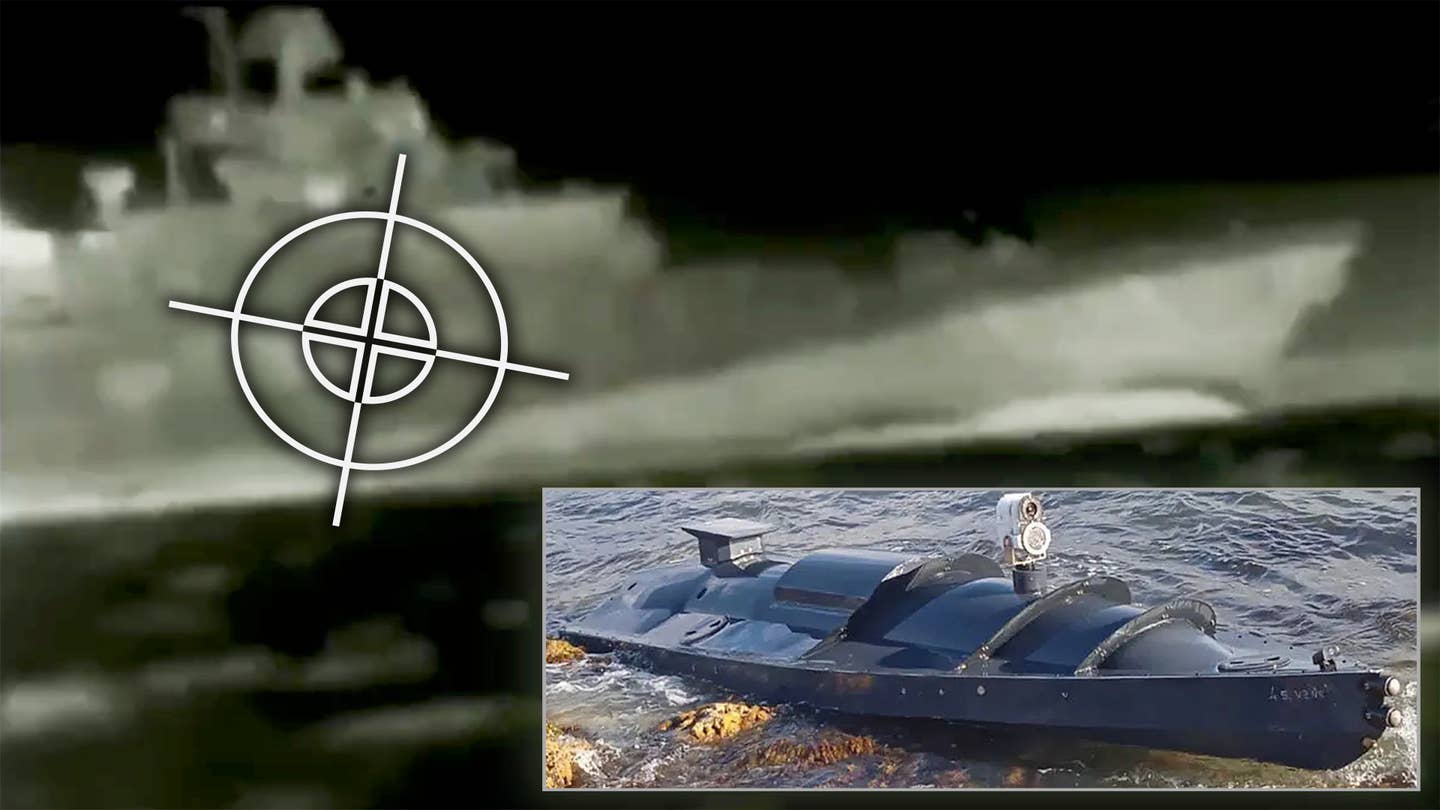A Look at Ukraine’s Attack On Russia’s Black Sea Fleet Headquarters
Russia says Ukrainian aerial drones and unmanned surface vessels targeted the home of its Black Sea Fleet, damaging at least a minesweeper.

The largest city in Crimea and the home of Russia’s Black Sea Fleet woke up to heavy explosions and anti-aircraft fire during an attack Russian officials say included aerial drones and especially unmanned surface vessels (USV), both of which were ‘suicide’ or ‘kamikaze’ types mean to explode when they arrive at their targets.
The Ukrainian Armed Forces have since released incredible footage purportedly from aboard several unmanned surface vessels used in the attack. The video shows the purported attack run on a guided missile frigate and Russian forces engaging the USVs with machine-gun fire.
The USVs appear to be of the same design as the mystery drone boat found near Sevastopol in September.
Russian officials claimed that only one vessel was slightly damaged while all Ukrainian aerial drones were destroyed and that “British specialists” were involved, without offering any proof. Russian-installed officials in occupied Crimea call it “the most massive since the beginning of the special operation.”
The low-light footage clearly shows a Project 11356R Admiral Grigorovich-class frigate — one of Russia’s most modern and powerful warships — underway, as well as Sevastopol harbor. There are reports that the Admiral Makarov, reportedly the Black Sea Fleet’s new flagship after the Project 1164 Slava-class cruiser Moskva sank in April, was damaged in the attack. At this time, The War Zone cannot independently confirm reports about damage to the Admiral Makarov, though the low-light footage from the USV appears to show it getting very close to the missile frigate before cutting to other video of the harbor and an explosion on CCTV.
Ukrainian officials previously claimed in May that the Admiral Makarov sank like the Moskva after being hit by Ukrainian anti-ship missiles, though this was later debunked.
Another video released appears to corroborate separate footage that showed a Russian Mi-8’Hip’ helicopter engaging a target off the coast. The USV is moving pretty quickly through the waves and heavy machine-gun fire, at one point only barely missing a small harbor patrol boat before a distant CCTV camera shows its likely demise out at sea.
Video from Sevastopol showed several explosions both in the water and near the port itself, and the Russian Ministry of Defense has since confirmed the minesweeper Ivan Golubets, a Black Sea Fleet Project 266M Natya-class, was damaged.
The Russian Ministry of Defense (MOD) said Ukraine launched an attack against its Black Sea fleet at 4:20 a.m. “with the participation of British specialists,” slightly damaging one vessel and a boom net, according to its Telegram channel.
The Russian MOD offered no proof to back up its claims.
The British Ministry of Defense (MOD) said Russia was “peddling false claims of an epic scale,” without specifically mentioning the Sevastopol attack claims. We have reached out to the British MOD for clarification and will update this story with any information we receive.
“The attack involved nine unmanned aerial vehicles and seven autonomous maritime drones,” the Russian MOD said. “The prompt measures taken by the forces of the Black Sea Fleet destroyed all air targets.”
During the attack, on the outer roadstead of Sevastopol, “four marine unmanned vehicles were annihilated by shipborne weapons and maritime aviation of the Black Sea Fleet, and three more were destroyed on the inner roadstead,” according to the Russian MOD.
“Minor damage was received by the sea minesweeper Ivan Golubets as well as the floating net boom in Yuzhnaya Bay.”
The Russian MOD said Russia “suspends its participation in the implementation of the agreements on the export of agricultural products from Ukraine.”
Russia claims they made the decision because of the “terrorism committed by the Kiev regime with the participation of British specialists” today “against the ships of the Black Sea Fleet and civil vessels involved in the security of the grain corridor.”
The Russian MOD said “the training of military personnel of 73rd Marine Special Operations Center were carried out under supervision of British specialists in the city of Ochakov, Nikolayev region in Ukraine.”
A month ago, The War Zone specifically highlighted how Russia had upped its security leading into Sevastopol’s harbor likely due to the threat of unmanned surface vessel attacks.
The attack was “the most massive since the beginning of the special operation,” according to RIA Novosti, citing Crimean occupation authorities.
In the wake of the attack, Crimean occupation authorities ordered city surveillance cameras and video streams from them will be closed to civilians, according to RIA Novosti. Security services, he said, “will deal with the already published video fragments that make it possible to detect the city’s defense systems,” RIA Novosti reported.
As we predicted at the time, a drone attack on Sevastopol’s Black Sea Fleet headquarters over the summer proved an incredible harbinger of the war’s next chapter. Ukraine has used improvised unmanned systems – primarily its so-called ‘Alibaba drones’ — to attack beyond its current territorial bounds and even into Russia proper. The introduction of unmanned drone ships configured as anti-ship weapons is an extension of these tactics. Russia’s use en-masse of Iranian kamikaze drones against Ukrainian infrastructure in the last two months, as well as Ukraine increasing its own kamikaze drone operations in an attempt to strike back, has further evolved at least one major facet of conflict into a drone war of sorts.
We will continue to update this post throughout the day as more information comes available.
UPDATE: 10:55 AM PDT—
Quick thoughts and analysis on today’s strike:
1.) If launched from land, these had to travel 130 miles at least. Not incredibly far in general, but for a small unmanned surface vehicle running on a jetski-like drive, there would be a major tradeoff between fuel capacity and explosives/warhead weight. That is if they were not ship-launched, but that would be a dangerous affair in that area as Russia keeps a close eye on movements in that area.
2.) The exact control concept for this drone boat is unclear. It appears to be a beyond-line-of-sight (BLOS) man-in-the-loop concept. If so, this has huge implications for something this small and relatively unsophisticated. It puts so many harbors at risk, over long ranges even potentially by non-state actors. They do not have to have close proximity/line of sight control of the craft to execute dynamic, reactive, opportunistic, maneuvering attacks. Of course, striking static targets would be possible beyond-line-of-sight without any man in the loop, which is also scary. But not dynamic maneuvering attacks like these today.
If this system relies on a BLOS man-in-the-loop concept, this is a new development in terms of operational combat use in naval warfare.
3.) On the other hand, it’s possible to get these into position autonomously using GPS navigation, then local ‘pilots’ picking them up within-line-of-sight to control them for their terminal targeting run. Big advantages here in complexity and retaining the ability to dynamically maneuver and target when it actually matters. Also could be a fallback for BLOS control setup.
4.) Bottomline, as we had mentioned repeatedly years ago as Iran began deploying improvised ‘suicide’ drone boats, including operationally, this would be a major threat to contend with in the future, especially when it migrates to better-resourced militaries. With that in mind, Ukraine is the perfect incubation chamber for drastically advancing these concepts and deploying them (in effect testing them and learning from those actions) operationally. These boats are akin to Ukraine’s ‘Alibaba’ long-range aerial suicide drones of the sea. Expect rapid evolution and capability enhancements.
As we have stated before, the same can be said for the Iranian drones Russia is deploying. Major improvements will result in such wide use and especially with funding from Russia. This is just an element of war in general, yes, but it is turbocharged in the still rapidly developing unmanned space.
Contact the editor: [email protected]

MORE TO READ
" Conservative News Daily does not always share or support the views and opinions expressed here; they are just those of the writer."

Now loading...